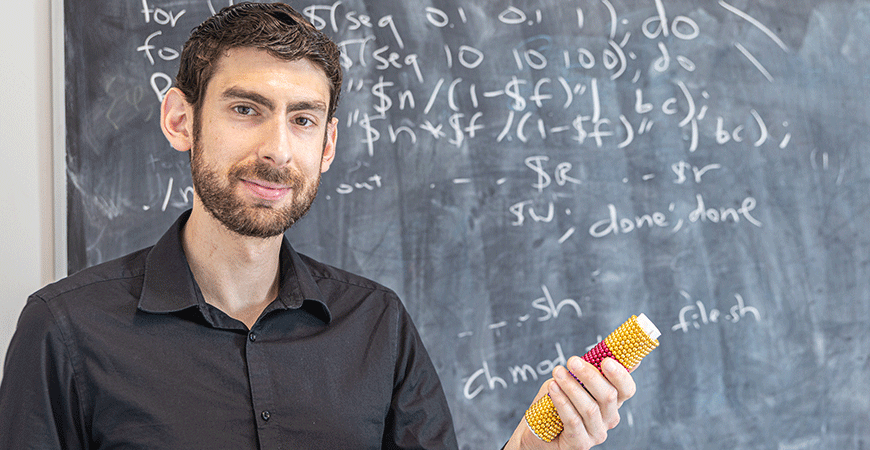
Physics Professor Daniel Beller has received a CAREER award for his research into how complex organization arises from simple physical interactions for biological cells or polymers assembled in large numbers.
He is the 26th researcher from UC Merced and the sixth from the Department of Physics — and the second this year — to earn a CAREER award from the National Science Foundation (NSF).
CAREER awards are among the NSF’s most prestigious awards. They are given through the Faculty Early Career Development Program to recognize untenured faculty members as teacher-scholars. Early-career faculty members are selected based on three factors: the strength of their research proposals; their potential to serve as academic role models in research and education; and their leadership in their field and organizations.
Beller will receive $570,000 over the next five years for his project “Geometries of Topological Defects in 3D Nematics, from Equilibrium Structure to Active Dynamics.”
Beller and his lab focus on soft matter physics, including liquid crystals and active matter. Active matter seeks the underlying physics involved in innumerable examples of collective organization and collective motion in the natural world, from bacterial colonies all the way to bird flocks. Active nematics are one prominent class of active matter and include intracellular biofilament assemblies, colonies of growing or swarming bacteria and the tissues of epithelial or neural stem cells.
Two basic factors unite these systems: the active forces exerted by each cell, biofilament or other “unit” and the tendency for neighboring units to align their long axes in parallel, like a crowded collection of tree logs floating on a river.
“Order emerges from these very simple interactions,” Beller said. “But the order can be interrupted by topological defects, places where the units unavoidably fail to organize.”
These defects can be moved or combined, but they cannot be smoothed out.
But in active nematics, topological defects are fundamental to the collective motion.
“These defects look like they are entities unto themselves, but they are actually patterns of organization, and their chaotic motions continually rearrange the underlying, force-exerting units,” Beller explained.
If scientists are going to use these phenomena in creating life-mimicking technologies, they must understand how the systems and the structures within them work. Eventually, the goal is to design materials with autonomous functional responses for the biomedical, industrial and consumer arenas.
“This physics of active matter, because of its wide applicability, is guiding the design of new, advanced materials that mimic functionalities of living systems, such as the capability to sense their environment, internally rearrange, move, divide or self-heal,” Beller explained.
Beller has been with UC Merced since 2018, when he began his faculty career. He is affiliated with the CREST Center for Cellular and Biomolecular Machines (CCBM).
“Dan’s work on three dimensional active nematics is path-breaking and the CAREER award is a reflection of this and his stature in the community for his educational and service efforts. We are proud to have such outstanding faculty in the department,” said Professor Ajay Gopinathan, Department of Physics chair and co-director of the CCBM.
Each CAREER award proposal includes an educational outreach component, and Beller is taking a three-tiered approach: designing a new graduate course in advanced statistical and soft matter physics; working with the CCBM and the Merced nAnomaterials Center for Energy and Sensing (MACES) to design professional development programs for undergraduate students; and working with the CCBM to offer hands-on outreach to area high schools to introduce younger students to how computer programming is used in science, employing everyday examples of soft matter physics to make the subject relatable.
He said he was honored to learn about the CAREER award.
“It’s thrilling to know I’ll have this support, but also just to be recognized by the research community,” he said. “This shows that other researchers believe our ideas are interesting and worth pursuing.”

